It’s been suggested elsewhere in these web-pages that we can judge the quality of a book by looking at its production as an object for carrying meaning. The space between the lines will tell us something about the quality of thought in the editorial-design processes, and so – because editor and writer might work hand-in-hand – in the writing too; and the glue on the spine will tell us something about the thinking in the publishing house.1 The recent book of conversations between Lee Konitz and Andy Hamilton may test this thesis to near-destruction.
First, we should get a taste of Lee Konitz’s art. Go to YouTube and you can find a number of extracts. These two seem to be the pick of the bunch:
Konitz and Marsh, and ‘what is cool?’
This is real television archaeology: we see Konitz playing with Warne Marsh and rhythm section in a TV-studio session, apparently from 1954. The interplay here between Marsh (tenor saxophone) and Konitz (alto saxophone) was one of the defining elements of the quintets they played in with Lennie Tristano (not playing here – a guitarist takes that part).2 Then Konitz is interviewed by the avuncular but rather sharp presenter.3 Konitz dismantles the usual preconceptions about ‘what is cool?’: his example is the ‘hot’ Louis Armstrong. The goal is ‘control’, when ‘all a musician’s energy goes into the playing’, and not into the extraneous signs of performance. The interview closes with the question ‘are you relaxed when you are controlled?’ Lee replies: ‘definitely’.
With Bill Evans
In a group led by pianist Bill Evans (presumably from the mid-1960s), Konitz takes the first solo. This passage shows his typical fusion of thinking and instantaneous composition, or instantaneous variation on a given melody. This thinking runs through every moment, but it’s most apparent in the pauses, while he gathers energy and listens to the drum and bass patterns (the young Niels-Henning Ørsted Pedersen). The film gives us a very close view of a player addressing his instrument, going to and from it, engaging with it with his lips and tongue in the production of sound. (One might compare this with an artist painting in oil – for example, Henri Matisse as recorded by François Campaux in 1946; there is an extract from that film here.) About ten years on from the earlier extract, Lee’s tone is now slightly rougher and more vocal: it is the voice of human conversation.
Before leaving YouTube, don’t miss this footage of the Tristano quintet playing at the Half Note in New York. This is an absolutely rare visual record of the milieu in which so much of this music was played: the audience members range all the way from the rapt to the not interested – or interested only in the other person at the table.
Dialogic
Now we can turn to the book at hand.
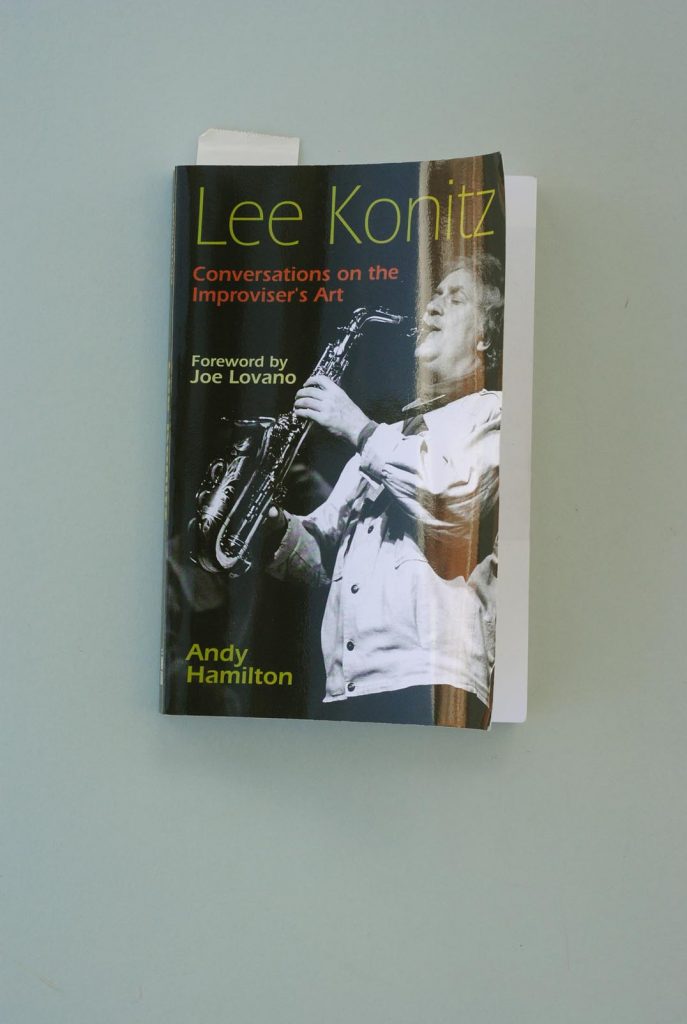
The cover of the paperback edition curls away from the book-block: the paper used is thin, and the lamination seems to add tension.

Caroline Forbes’s wonderful photo of Lee enlivens the title pages.
The book Lee Konitz is, as its subtitle says, a book of conversation. Konitz and Hamilton are the main speakers, but thirty-odd other voices are heard, in short sections interspersed in the main dialogue. These are the voices of colleagues and collaborators and friends of Konitz. The source of these interviews is exactly given by Hamilton in endnotes: year and month, and whether by telephone, by email, or a combination of the two. So too, Hamilton takes trouble to explain the kind of editing that he has employed in transcribing Konitz’s voice, giving a typical unedited transcript and the words as they were then refigured for publication in print. The differences are very small. Hamilton remarks that ‘Lee Konitz is one of the few jazz players who could sustain the reader’s interest over so many pages’, and, on the evidence of the book they have produced together, we know that this is true. Konitz is, as his interviewer says, ‘a true thinker with gravitas’.
Dialogue is an entirely apt form for the subject of improvisation. As one can see in Konitz’s interactions with other players, that is his method: a kind of thinking on one’s feet, in dialogue with other players. So, to some extent, the form finds itself through the conversation: the form of the piece is not pre-set; there is no ‘endgaining’. Konitz’s playing is a prime case of an ‘Alexandrian’ approach.
AH: So do you feel there’s a difference in your tone when you’re a little tense during a performance?
LK: Yes, definitely. Pitch is the first thing that goes; there’s a tendency to push up the high notes, so that in contrast the lower register sounds flat when I come down there. So that’s one of the things I really concentrate on a lot when I’m practicing.
Certainly one’s tone changes with the degree of tension involved – the throat tightening, the mouth and facial muscles tense, the breathing shallow, and so on. It has to change the sound that comes out. Just listen to the same player when he’s relaxed – a very obvious difference.
AH: When you’re tired, that’s the same problem.
LK: I think so. It might have the opposite effect – but again, it’s not the best sound production.
(pp. 180–1)
Notice the switch of thought in the last part of this exchange: Hamilton brings in a new idea; Konitz confirms it tentatively, then qualifies this (‘It might have the opposite effect’), then states a way in which there is some comparison between being tense and being tired. What ‘the opposite effect’ might be, exactly, he doesn’t say. The thought appears very briefly, without being developed. This is Lee in conversation, and it is very much as he plays. It’s like his long legato lines – hallmarks of the Tristano approach – in which the thoughts twist and turn, get developed, then he pauses for breath and reflection, before he proceeds to play again.
Typographic
Andy Hamilton’s words in the conversations – it feels wrong to call them interviews – are set in bold, Lee Konitz’s are in the ordinary weight of the typeface used; in the quotation above I haven’t followed this, but instead added the speakers’ initials. The two weights for the two voices makes for a strong difference. I think it’s too strong, and would have preferred an equality of weight for the two voices. The design of this book, while careful and considered, is pretty conventional. The book belongs to the University of Michigan’s ‘Jazz Perspectives’ series, and some of its design must follow series style.4
The editorial-typographic embodiment of the material seems to be as follows. Chapters are introduced by Hamilton, his text set in the normal weight of the typeface. Then there is a line-space and the dialogue starts, Konitz in normal, Hamilton in bold.
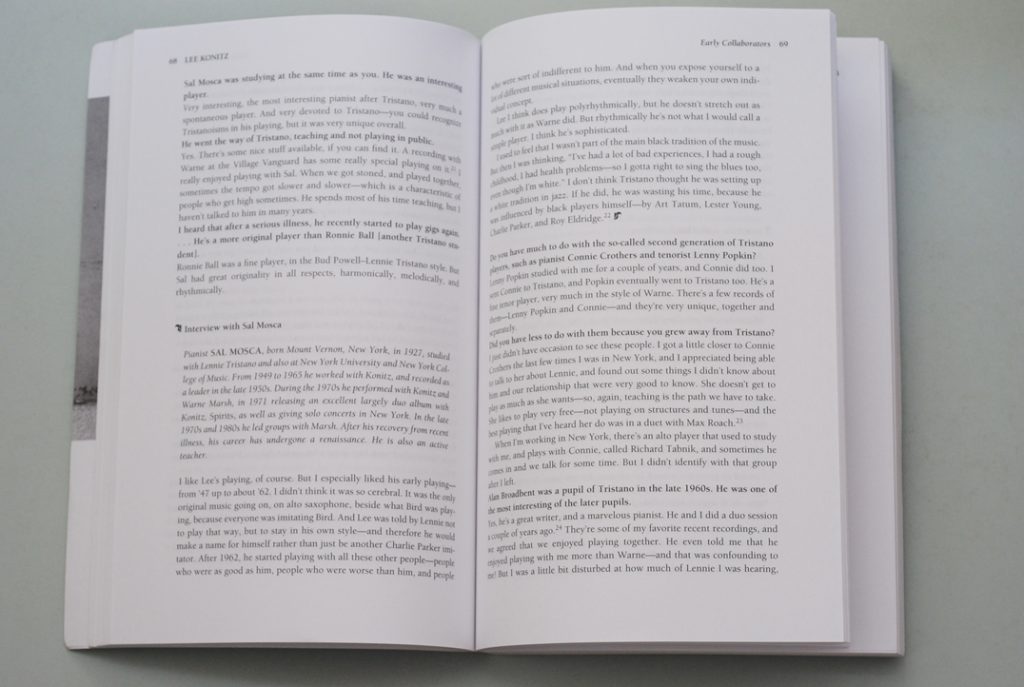
The interviews with other people are indented and signalled by an ornament followed by a heading. Hamilton introduces these sections with a description of the new speaker, set in italic. The ornament, now reversed, closes the section. But this indentation often breaks down, as on the second page of this spread, where only the closing ornament is there to indicate the end interview with Sal Mosca, and the resumption of the Hamilton–Konitz conversation.
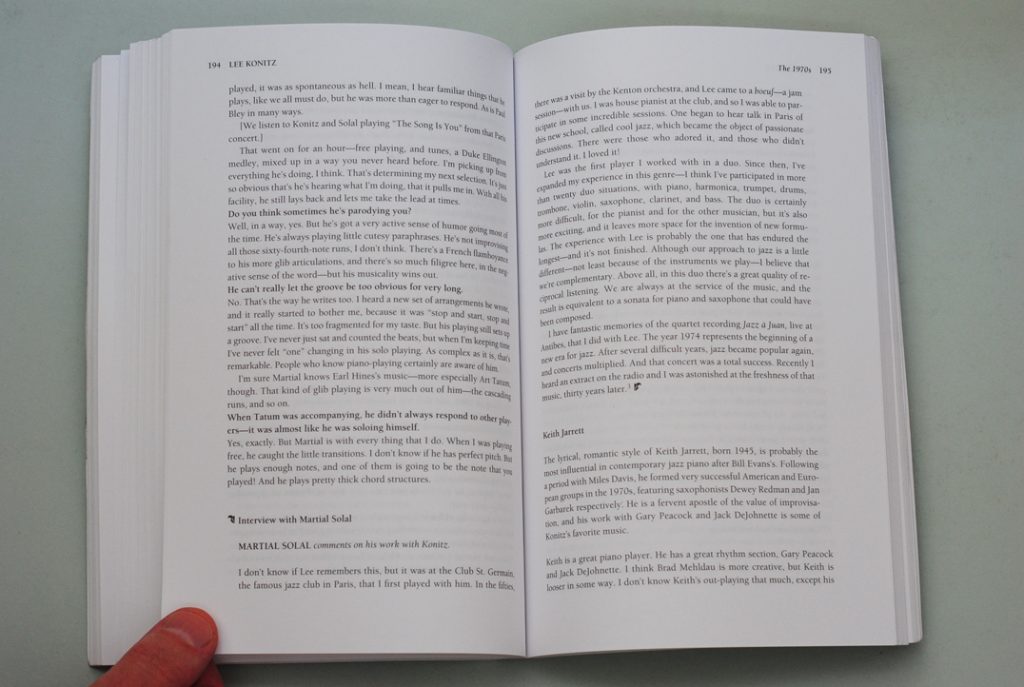
Elsewhere there seem to be other inconsistencies: Hamilton’s introductions to another player are sometimes set in roman rather than italic, and without indentation. Sometimes I got lost and had to read back or forward to be sure of whose voice I was reading.
One has the feeling that the editorial-typographic conventions could have been more consistently applied, and that certain other means might have been more appropriate. For example Andy Hamilton’s voice might have been set in another typeface altogether (maybe a sanserif), rather than this uncertain switch between bold, roman, and italic, of the same typeface.
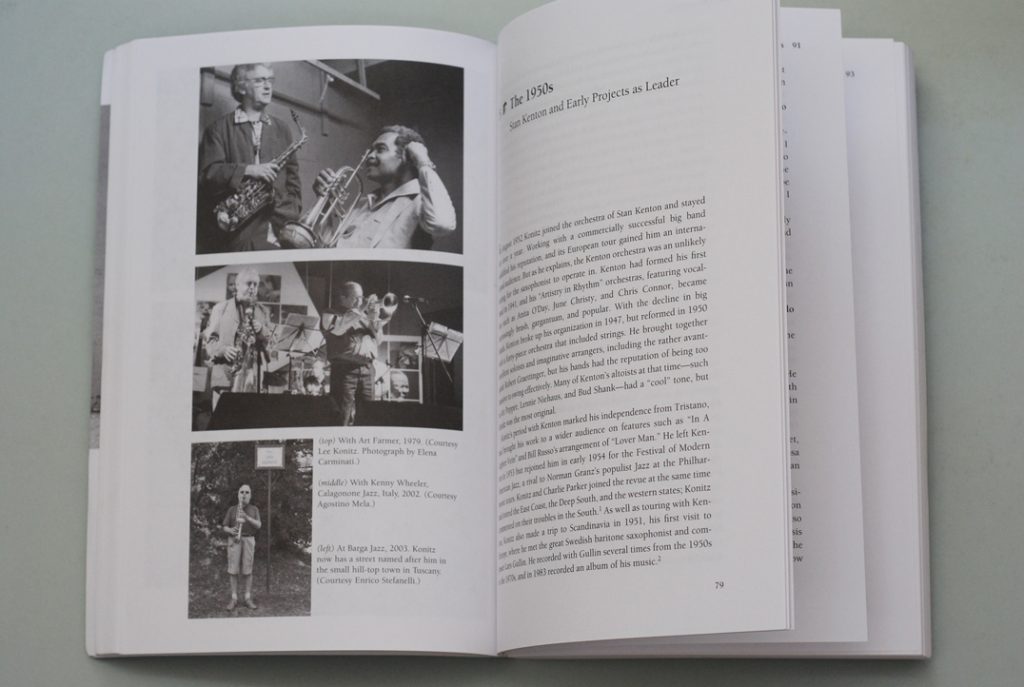
The book shows a number photographs of Konitz through the years – very welcome – but gathered absolutely conventionally in a clump of 8 pages, though there is no technical necessity in this. The book uses a loose chronological structure. One could imagine this chronological sequence of pictures spread out at intervals through the book. Or perhaps pictures grouped in a clump is the best way. One feels that the decision has been made merely by the conventions of book production.
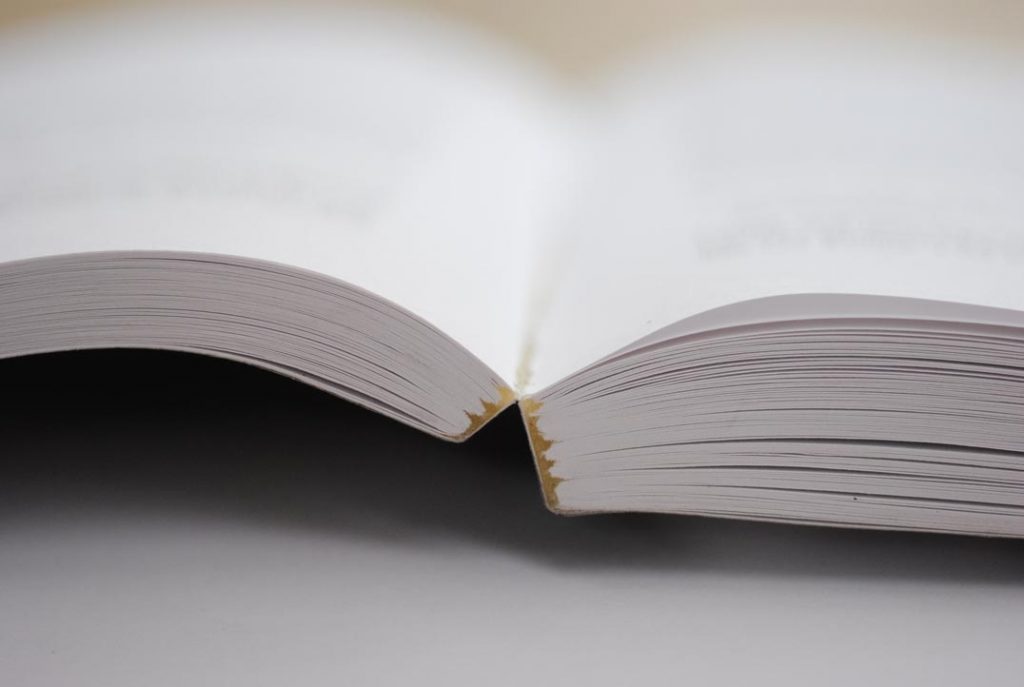
I have to mention the binding (of the paperback edition – there is a hardback edition too), which is ‘burst-bound’ – meaning that there is some residue of the sections of the book still evident, but that they are held together just by glue (no thread).
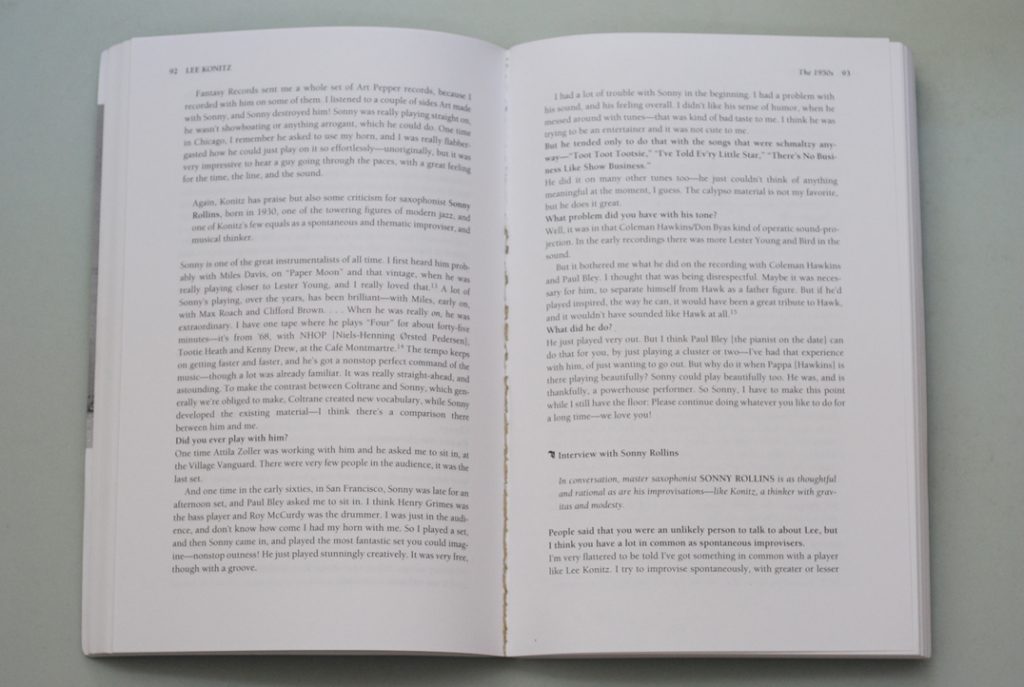
Open at the big crack.
It doesn’t function well: it is one of those many books that can be opened brutally in just one place, where it cracks and threatens to split into two parts.
Editorial
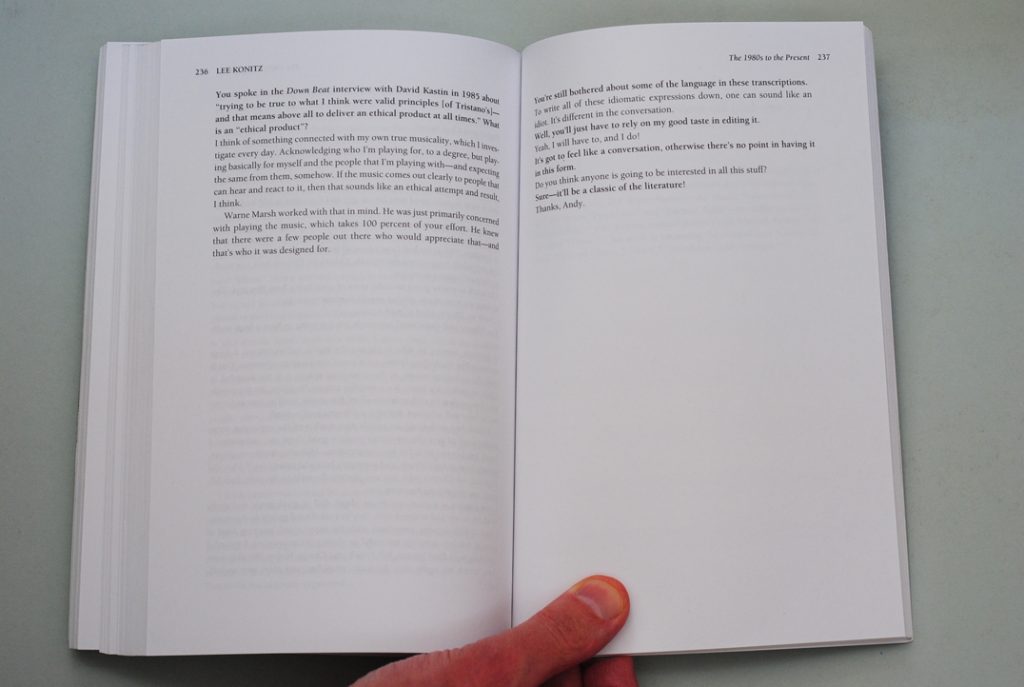
Right at the end of the book there is another hint that Hamilton, with Konitz, has wanted to shape the way in which the material has been embodied – and that, with more flexibility and some special attention from its editor and designer, the book could have become a more responsive artefact. The conversation comes to an end, with Konitz thinking aloud about the function of music and its possibilities (yes, true gravitas). Then the rest of the page is empty and on the next page we find an epilogue, in which the two of them reflect on what they have been doing:
AH: You’re still bothered about some of the language in these transcriptions.
LK: To write all of these idiomatic expressions down, one can sound like an idiot. It’s different in the conversation.
AH: Well, you’ll just have to reply on my good taste in editing it.
LK: Yeah, I will have to, and I do!
AH: It’s got to feel like a conversation, otherwise there’s no point in having it in this form.
LK: Do you think anyone is going to be interested in all this stuff?
HK: Sure – it’ll be a classic of the literature!
LK: Thanks, Andy.
Hamilton lives up to Konitz’s values of honesty and clarity of thought. As here and in the passage about transcription, he is open about his procedures and is able to reflect on them. Elsewhere, in an endnote (p. 260), he introduces another critical voice, quoting some remarks on the text by the book’s series editor, Lewis Porter: ‘You and Lee are both dead wrong …’ We even sit in on a brief music lesson (pp. 141–2) between the two main characters: Hamilton plays the piano and Konitz comments with straight-to-the-point honesty. (As well as playing piano, Hamilton is a philosopher and teaching philosophy is his ‘day-job’.)
AH: I do usually try and start it quite simple, with some simple motif. But too often the faster passages are quite mechanical.
LK: Well, it sounds very mechanical. It sounds like you’ve really worked out something to make an effect, and it’s not going to go anyplace. If you want it to go someplace, you have to really simplify quite a bit, I think.
The book is rounded off with examples of Konitz’s compositions and transcriptions of some of his recorded solos. There is a short checklist of Konitz’s huge number of recordings (a more complete discography is available on the publisher’s website), and what looks like a fairly complete bibliography of writings about the subject. The index is extensive and well-organized. The book is indeed an outstanding contribution to the literature of jazz and, I’m tempted to add, to the literature of human endeavour.
Note
1 This is one of a sporadic set of considerations of recently issued books and their production. Previous pieces: on a Persephone series, on books from Verso, on another one from Verso, on Benjamin and Brecht in English.
2 In the book, David Liebman has this sharp observation: ‘Warne played tenor like an alto, while Lee plays alto like a tenor, with a really dark, bottomy sound. Those heads [statements of the main theme] they played together are so hard …’ (pp. 181–2)
3 This is Gilbert Seldes, a figure of some considerable interest.
4 One could compare this book with another book of conversation about music, our own Morton Feldman says. I think, with the latter, one sees the advantages of an individual editorial-design response to the material.
Robin Kinross